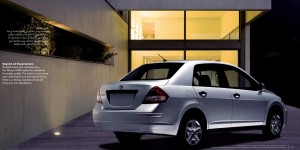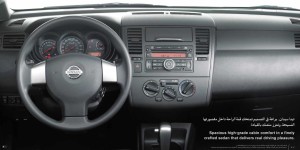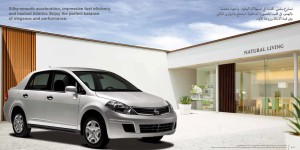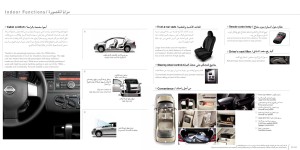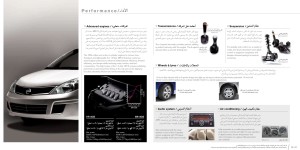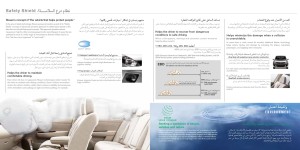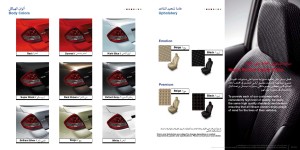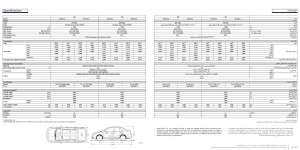Why I Love Nissan Tiida / Versa 4-Door Sedan
Nissan Tiida as it is called in Asia is called Versa elsewhere. It’s my first car, actually, more like my wife’s first car, since we bought it for her work. I can get around by bus, but she has to drive to work. I was looking for a small car that’s just right for our needs. We were limited on budget, so we picked a second-hand car. Thank God that my father-in-law happens to know someone in the second-hand car business and he was a car mechanic, so he really knows about cars, and he made sure the car was in a good condition.
We ended up with a Nissan Tiida / Versa. So what made us choose it?
1. Economy
Of course, with limited budget, we couldn’t afford a very expensive second-hand car. We had to find the best-for-value car within our financial ability. The 2011 Nissan Tiida / Versa fitted the range. I wanted one that was fuel conservative as well. Nissan Tiida / Versa probabaly wasn’t the MOST fuel conservative car on the road, but it was above average, and that was pretty good for me. If it had a fifth gear like on Honda Civic 8, then I’m pretty sure its fuel consumption would have been as impressive as Civic on the freeway. In the city, it is no less fuel conservative than Civic (perhaps more conservative) and is pretty good for me.
Also, a car mechanic told me that Nissan has the lowest maintenance fee in Taiwan. That is another big plus for the purchase.
2. Passive Safety
I am big on passive safety. Why? Because even with all the active safety and careful driving, there are always careless drivers who may run into you or make you crash. The ultimate safety comes down to passive safety. Rated about 4 stars in crash test result, the car was in serious consideration on my list. No, I couldn’t afford a 5-star car. The cheapest I could think of was Honda Civic 7, but the second-hand car market for Civic 7 was either cars having problems you wouldn’t want, or there weren’t any available at all. All are still owned and driven by their owners. Civic 7 was too difficult to obtain.
For the money I could afford, this car has a pretty good crash test result.
3.Space – THE Greatest in Its Class
Space wasn’t my priority. Not until I got in the car. I was impressed with the space it offered. It was a lot bigger than I expected. I thought Honda Civic 8 was pretty spacious for a small car. Nissan Tiida / Versa was even more impressive. It felt huge. It felt even more spacious than a Honda Accord. Except for its width, it even felt comparable to a Toyota Windom (also called Lexus ES300), which was a pretty big car (4,865mm long, compared to Tiida / Versa’s length of 4,470mm).
My wife is pretty tall for an Asian woman, about 177cm (nearly 5′ 10″), which is quite a bit taller than me. Even with the front seat fully slid back, there was ample legroom for her in the rear. The space in the front seat was also awesome. It felt like a much bigger car.
We bought the 4-door sedan version. I wanted the 5-door hatchback version, but it was more expensive, and after evaluating our needs, a 4-door with the longer rear was more suitable for us. Why? Because when the car was seated with 5, it had a bigger boot space, no less than that of Honda Civic 8. In the 5-door version, it was either sacrificing the trunk or the space for the rear passengers by sliding the rear seat forward or back. The sedan version was more what we needed. Seriously, I’d love a wagon version of Nissan Tiida / Versa, but Nissan doesn’t make it.
Luggage space is impressive. In terms of numbers, it is about the same as Civic 8, being only 18 liters less at 467 liters. In my experience, however, the actual usable space is even bigger than Civic 8’s trunk. This is because the rear speakers in Nissan are mounted in the rear doors, not the rear shelf silencer as in many cars, which always has the rear side of the speakers sticking out into the trunk. The trunk space is also designed with minimal intrusion by cables and lines. This means almost the whole space is usable – you can almost fill it up too the very top of the trunk. That makes the practical space of the trunk even bigger than Civic 8, which is a slightly bigger car. Awesome.
The greatest advantage of Nissan Tiida / Versa is of course the space it offers. There is no parallel. After having owned Nissan Versa / Tiida, I really don’t know where else I can find a small car with the space and comfort it provides.
4. Active Safety and Handling
Active safety wasn’t on the top of my list, since most cars are okay to drive, especially Japanese cars, which are pretty reliable. None of us drive like race drivers. We’re peaceful on the road, so I wasn’t too worried about the handling. What surprised me was that reviews of this car said the car drove like a European car. Without much experience with European cars, I didn’t know what it was like, and I was looking forward to it, because, frankly, Europe made the best cars in the world. Nissan is now owned by the Renault group. Renault has some touch on Tiida / Versa’s chassis (reports say Nissan Tiida / Versa uses Renault’s chassis), making it drive more like a European car.
I drove the car on the freeway and in the mountains. Two third of Taiwan is consisted of mountains, so we get plenty of turns and twists and ups and downs. That is one place to really test out the handling of the car legally and without having to go beyond your skills. I was impressed. The car handled very well. Its firm chassis absorbed shocks well enough to allow my wife’s students (she is a teacher) in the rear seat to fall deep asleep. My wife gets car sick very easily. After nearly a whole day around the mountains, she showed no sign of discomfort at all.
I was following a Honda Civic 6 who was leading the way. He wasn’t going too slow. I could catch up with Honda Civic 6 (which was basically a sports-ready family car) without too much effort, and the car was comfortably within its limit. Steering response was great and accurate. The steering wheel was light but still had sufficient feedback.
Thoughtfully by Nissan, the steering wheel is light when the car is at low speed, and seems to pick up weight as the speed increases. When on the freeway, driving at 100km/h or 62mph, the weight of the steering wheel is just right, and clearly a lot heavier than when the car is going slow. That is a SAFE design, desirable in all cars. Great job, Nissan!
Headlight can also be an important factor in safety. The headlight on Nissan Versa / Tiida is very bright. The version I bought, despite the fact that it isn’t the most luxurious in its version, has a 3-increment angle adjustment for the headlight, so I can adjust the angle I need and see further without having to use high beam. I can choose lower angles for going around the city so my headlight doesn’t blind other drivers on the road. The fog lamps do not shine very far to the sides as in Civic, but helps broaden the vision nonetheless, and adds even more to the overall brightness. Of course, with high beam and fog lights on, and you’ll get a great view of the road in front of you in the dark. It’s very bright.
But, sadly, no car is perfect. For a car at this price, there is no ABS (anti-lock brake system) (the version in Taiwan has reduced safety package, which is a shame). In an emergency, particularly on wet roads, ABS can be important. We have to know how to brake without ABS. If you feel the wheels kid against the ground even a little, lift up the brake pedal a bit. Remember this, and ABS is probably not necessary. However, ABS is still better for most people. I reminded my wife this technique numerous times. I’ve never had the need of ABS in all my 17 years of driving, but it’s hard to tell what will happen in the future. Let’s just hope and pray that we’ll never need ABS.
5. Engine
The engine is 1.6-liter with 109 horsepower at 6,000rpm and 152NM of torque at 4,400rpm. European engines are awesome with high torque at low revs. This provides great engine flexibility. Japanese cars are not renowned for making flexible engines, as their torque usually peaks at above 4,000rpm. Nissan Tiida / Versa is no different. What’s different however, is the surprising amount of torque it already offers at low revs.
Image in courtesy of Nissan:
At 1,000rpm, the engine already releases about 120NM. That’s 78% of its peak torque output. At 2,000rpm, torque output is about 133~134NM, which is about 87% of its peak torque. In all of its usable range, the torque output is never less than 120NM, or 78% of its peak torque. That’s not bad at all! A reasonably flat torque output, which means sufficient power even at low revs, giving the engine more flexibility than the peak figures appear to be.
Indeed, the car doesn’t feel very powerful, but it provides adequate acceleration for all road conditions except when you’re trying to race. I’ve overtaken a slow car in the mountain roads, and it did quite okay. Its acceleration reads 0~100km/h (62mpg) in 11.1 seconds, which is acceptable for a family car. Not quick, but adequate.
What is great about the car is that since the torque curve is relatively flat, the acceleration at low revs is sufficient for city road conditions. If I pump the engine to around 1,900rpm and no further, the acceleration is a little slower than most of the cars on the road, but very close. If I go up to 2,000rpm, the acceleration catches up with most cars, meaning that is just right for city conditions. If I pump it up to 2,100~2,250rpm, I’m going faster than most. That is impressive. The torque output at low revs allows me to go sufficiently quickly on the road while saving much fuel.
We’re not race drivers. The car is just for family use. I can say, the engine may feel underpowered at first, but observe and read the figures, and you’ll realize that it’s actually adequate and sufficient for basically all road conditions. Not to say, you save a lot more on fuel than more powerful cars. As long as you’re not after great performance, it will do well in its job, and definitely fits various road conditions.
6. Transmission
I put a lot of emphasis on the gearbox, because the gearbox is the most important thing when it comes to utilizing the engine’s power. The engine power is pretty much fixed, so it’s up to the transmission for the rest of its performance. Again. Toyota’s automatic gearbox is like, “Oh wait I’m a little hampered by what you’re asking, or I don’t get you. I’m working on it now, please wait!” Toyota’s transmission is slow to respond, and slow to work. Not impressed.
Honda’s automatic transmission is more obvious when changing gears. You can feel it. It is quick to respond, and does not delay for even a split second. Great transmission.
I was a little worried about Nissan. What about Nissan’s transmission? The only other Nissan car I have driven is more than 10 years ago. It was a Skyline GT-S, which was a sports car. I forget what it is like, and it wouldn’t be fair to compare a sports car to a family car.
Nissan Tiida / Versa’s automatic transmission really impresses me. When I kick down on the accelerator, it lowers the gear instantaneously and acceleration picks up responsively. When going up the gear, it is very smooth. You almost can’t feel the gear being changed (in fact, you don’t feel it, unless you pay special attention to it), but the work is done so quickly. Even when you apply engine brake, the manually selected lower gear suffers no delay. You gotta kick down on the accelerator a bit for the gear change to have a smooth engine brake (as with all automatic transmission), or else you’ll feel the sudden “thump” and rather quick deceleration by the engine, because the transmission works so flawlessly responsively (not good on the clutch though).
When going up slope on the freeway, Toyota Tercel struggles because of its less efficient gearbox. Honda Civic 8 does okay in fully automatic mode, but soars in Sport mode because of the change in torque converter mode. Nissan Tiida / Versa also does as well as Honda in this area. There is no “Sport” mode to select with the automatic transmission, but if you press the accelerator down a bit deeper, it doesn’t go down a gear, but changes the torque converter mode, perhaps to release it from the clutch. The engine is free to rev up and release more torque and power without being dragged by the weight of the car. It goes up the fairly steep slope (the steepest on the freeway in the mountainous terrain of Taiwan) at 80km/h or 50mph at 2,250~2,500rpm (instead of the usual 2,000rpm) almost effortlessly while saving much fuel because of its sufficient torque and highly efficient transmission design. I don’t have to go deep with the accelerator. Impressive.
In short, the transmission on Nissan Tiida / Versa is very smooth, so much so that you basically can’t feel it, yet so responsive everything is done instantly, and an automatically employed “sport” mode when it is needed. I can’t praise the transmission more. I love it.
7. Quietness
Noise is not my primary concern when picking a car. However, Nissan Tiida / Versa’s sound insulation is impressive and beyond my expectation. The sound insulation is much better than Honda Civic 8, which isn’t known for its soundproofing ability. Noise from the outside is kept out pretty well. Its soundproofing performance is particularly impressive when considering the price tag it carries.
The engine is also very quiet. In fact, if you don’t pay attention and the engine is already running idle, it is easy to accidentally fire up the engine again, which is not good for the engine. The quietness is impressive. It’s almost silent.
Conclusion
I bought the car mostly because of its cost, economy, and the space it offered. Yet after driving it for more than 6 months, on the freeway, in the city, in the mountains, etc., I can only say that the more I learn about the car, the more I’m happy with it. The engine quietness, acceptably flat torque output, super responsive yet smooth transmission, etc. all fit very well to my needs.
The dashboard has a multimedia screen in the center that is responsible for GPS navigation, radio, reading multimedia files from USB drive, reading multimedia files from SD card reader, CD player, and even digital TV. It is extremely versatile. It leaves only the air conditioner and fan adjustment out, which means the dashboard is extremely simple and clean. No, my car doesn’t have automatic temperature control, but I do well with manual control.
Not every car has to be a sports car to be rated well. A lot of the car magazines have this misconception that a car has to handle like a sports car and drive like one to be a good car and get high ratings. A good car is one that fits your needs well. I can say, this car fits all my needs very well. It’s a great car for me.
Er no, this is not an advertisement for Nissan. I merely express my impressions as a car owner.
Photos extracted from Nissan’s catalog:
Written on March 31, 2015 at 11:48 am




